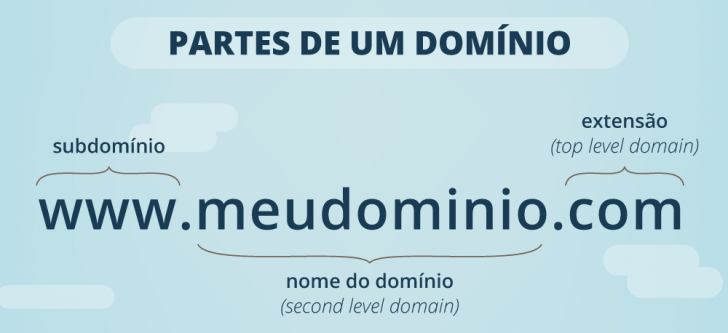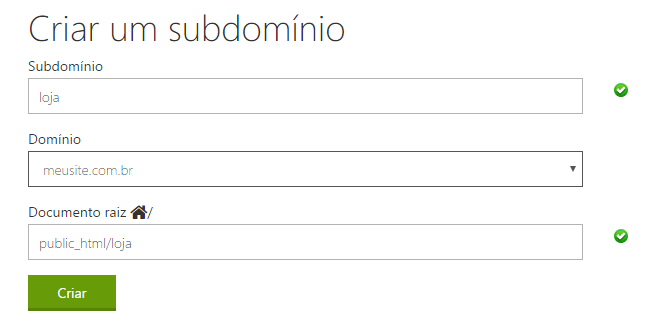If you are interested in creating a website or expanding your understanding in this field, you may have encountered the concept of subdomains. If you are unsure about this term, do not fret. You have come to the right place to understand what a subdomain is. 😊


It is crucial to understand fundamental concepts related to website publication, such as domains, hosting requirements, and the utilization of subdomains for site enhancement.
Discover all the potential of subdomains in this article and explore the many opportunities they offer!
Understanding the components of a domain
The domain serves as the unique e-mail address for your website, enabling people to access it online. It is exclusive to your site and in this case, the domain is “ourrequests.com.br.” Subparts make up a domain, as illustrated in the accompanying image.


We will now explore the meaning of each of these components.
Extension of the area
After the point, the domain extension from right to left signifies the type or category of the domain. Known as TLD, or top-level domain, in this instance, the domain’s TLD is .com, a widely used domain extension that typically denotes commercial intent.
If the address extension were .com.br, it would include a ccTLD, which stands for country code top-level domain. This code signifies the specific country to which the website belongs. Each country globally has its unique code, making it easier to identify the site’s nationality for both users and search engines.
Domain name – Name of a website
In the example provided, the central part of the domain is referred to as the domain name, which is the unique part of the address known as the second level domain.
The domain must be registered with a company that offers this service globally before you can use it on your website.
Subdivision
The subdomain, which is typically denoted by “www,” directs users to the main page of a website. Accessing a website using the www prefix will lead to the same content as accessing it without the prefix.
Any text can be utilized as a subdomain, providing the site administrator with limitless options.
One of the main purposes of a subdomain is to establish distinct sections within the main website that are easily identifiable by the subdomain. It is typical to see subdomains used for purposes such as a store, blog, events, and more.
Sublevels can be incorporated into subdomains, like checkout.store.mywebsite, to establish hierarchical structures. Exercise caution to avoid overusing this option and getting overwhelmed by numerous possibilities.
We will next observe best practices for utilizing subdomains and things to steer clear of.
When should a subdomain be utilized
Subdomains serve as an expansion of the primary domain, enabling you to guide your website visitors to an alternative address with unique content.
Subdomains are commonly utilized to categorize and segregate content from a website into separate sections when the content differs significantly from that of the main domain.
Another frequent application of subdomains involves implementing targeted marketing or commercial campaigns. For instance, if your company’s main website is located at mycompany.com.br, which is used for promoting services to the public, you may choose to launch a separate section for offering courses to visitors. In this case, you could set up a subdomain like courses.mycompany.com.br.
Developers and web designers frequently utilize a subdomain for testing and refining improvements, which is kept private from the public. The subdomains such as dev.meusite. and temp.meusitis. can serve this purpose effectively.
Avoid using a subdomain in certain situations.
Due to the extensive options for creating subdomains, understanding the information hierarchy is crucial. In a time of boundless opportunities, it’s easy to become overwhelmed by the sheer volume of possibilities and find yourself tangled in complex information. If the site’s organization is confusing for its creators, it will be even more so for visitors.
Be cautious when considering whether to create a subdomain for each section of your website. Ask yourself if the section could simply be a page on your main domain instead.
Some information can be effectively structured using a categories system, resulting in URLs such as mysite.com/category-x/ and mysite.com/category-y/.
Creating a subdomain explained
Site hosting services make it easier to manage different parts of a website, such as subdomains, which can be set up using the hosting control panel.
The domain and subdomain management area’s position differs depending on the company. Companies using the cPanel control panel have a designated section for managing subdomains, as shown in the example of GoDaddy’s cPanel domain management area below.


When you create a subdomain in cPanel, a directory is automatically included in your hosting account to store the files intended for that subdomain. You have the flexibility to rename this directory, and it does not have to match the subdomain name. Here is an example of setting up the subdomain “store.mysite.” using cPanel.


A subdomain can be directed to an IP or another external server, providing redundancy for specific parts of a website, such as accessing a blog through different addresses.
In summary
There are many options for establishing subdomains and their uses on a website when a new section with different content or purpose from the original site is required.
Do you have any inquiries or would you like to contribute to the article? Feel free to contact us! We’re here to assist. 🙂
Published on 02/03/2017 and revised on 28/06/2018.
Concepts are marked by tags.
